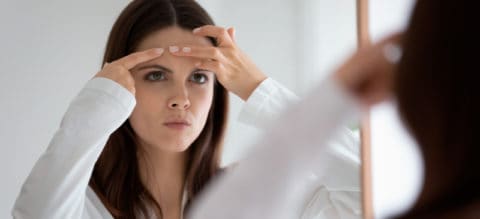how to get rid of fungal acne skincare by hyram How to get rid of fungal acne (plus symptoms and causes)
If you’ve ever dealt with mysterious bumps on your face that just won’t go away no matter what you do, they might be fungal acne. Unlike traditional acne, fungal acne is caused by an overgrowth of yeast on the skin. But don’t worry, there are steps you can take to get rid of it. First and foremost, it’s important to correctly identify if you have fungal acne. Some symptoms include small, red or white bumps on the forehead, jawline, or cheeks that don’t respond to traditional acne treatments, itchiness, and a greasy or oily appearance. If you’re unsure, it’s best to consult a dermatologist. Once you’ve confirmed that you’re dealing with fungal acne, the next step is to address the root cause: the yeast overgrowth. One way to do this is by incorporating antifungal ingredients into your skincare routine. Look for products with ingredients like tea tree oil, sulfur, or azelaic acid. In addition to using antifungal products, it’s important to keep your skin clean and dry. Fungi thrive in warm, moist environments, so make sure you’re not leaving sweaty clothes or damp towels on your skin for too long. It can also be helpful to change your pillowcase frequently to prevent the buildup of yeast and bacteria. Now, let’s dive into some specific products and tips for treating fungal acne: - Tea tree oil: This natural ingredient has antifungal properties and can be found in many skincare products. Some options include The Body Shop’s Tea Tree Oil Anti-Imperfection Daily Solution and Australian Bodycare’s Tea Tree Oil Skin Wash. - Sulfur: Sulfur is another ingredient that can help combat fungal acne. It works by drying out the skin and disrupting the yeast overgrowth. Some popular products include Sunday Riley’s Saturn Sulfur Acne Treatment Mask and Kate Somerville’s EradiKate Acne Treatment. - Azelaic acid: This ingredient has both antibacterial and antifungal properties. Some options include The Ordinary’s Azelaic Acid Suspension 10% and Paula’s Choice 10% Azelaic Acid Booster. In addition to incorporating these ingredients into your routine, it can also be helpful to avoid certain triggers that can exacerbate fungal acne. These include things like wearing tight clothing that doesn’t allow your skin to breathe, eating a diet high in sugar and processed foods (which can promote yeast growth), and using heavy, oil-based products on your skin. Overall, dealing with fungal acne can be frustrating, but with the right products and approach, it is possible to get rid of it. Be patient and consistent with your routine, and don’t be afraid to seek help from a dermatologist if you’re struggling. Happy skin care!
If you are searching about FUNGAL ACNE REMEDIES- Clean & Clear Skin - The Natural DIY you’ve came to the right web. We have 5 Images about FUNGAL ACNE REMEDIES- Clean & Clear Skin - The Natural DIY like HOW TO GET RID OF FUNGAL ACNE - Sharon Malonza, Here’s Exactly How to Treat Fungal Acne & Get Clear, Glowing Skin – Brooke’s Beauty Bazaar and also FUNGAL ACNE REMEDIES- Clean & Clear Skin - The Natural DIY. Here it is:
FUNGAL ACNE REMEDIES- Clean & Clear Skin - The Natural DIY
 thenaturaldiy.comacne fungal remedies skin clear clean natural oil
thenaturaldiy.comacne fungal remedies skin clear clean natural oil
HOW TO GET RID OF FUNGAL ACNE - Sharon Malonza
 sharonmalonza.comfungal acne
sharonmalonza.comfungal acne
How To Treat Fungal Acne | Acne Skincare Routine, Acne, Chest Acne
 www.pinterest.comHere’s Exactly How To Treat Fungal Acne & Get Clear, Glowing Skin – Brooke’s Beauty Bazaar
www.pinterest.comHere’s Exactly How To Treat Fungal Acne & Get Clear, Glowing Skin – Brooke’s Beauty Bazaar
 brookesbeautybazaar.comacne fungal glowing
brookesbeautybazaar.comacne fungal glowing
How To Get Rid Of Fungal Acne (Plus Symptoms And Causes) - Dr. Axe
 draxe.comfungal causes
draxe.comfungal causes
Here’s exactly how to treat fungal acne & get clear, glowing skin – brooke’s beauty bazaar. Acne fungal glowing. How to treat fungal acne